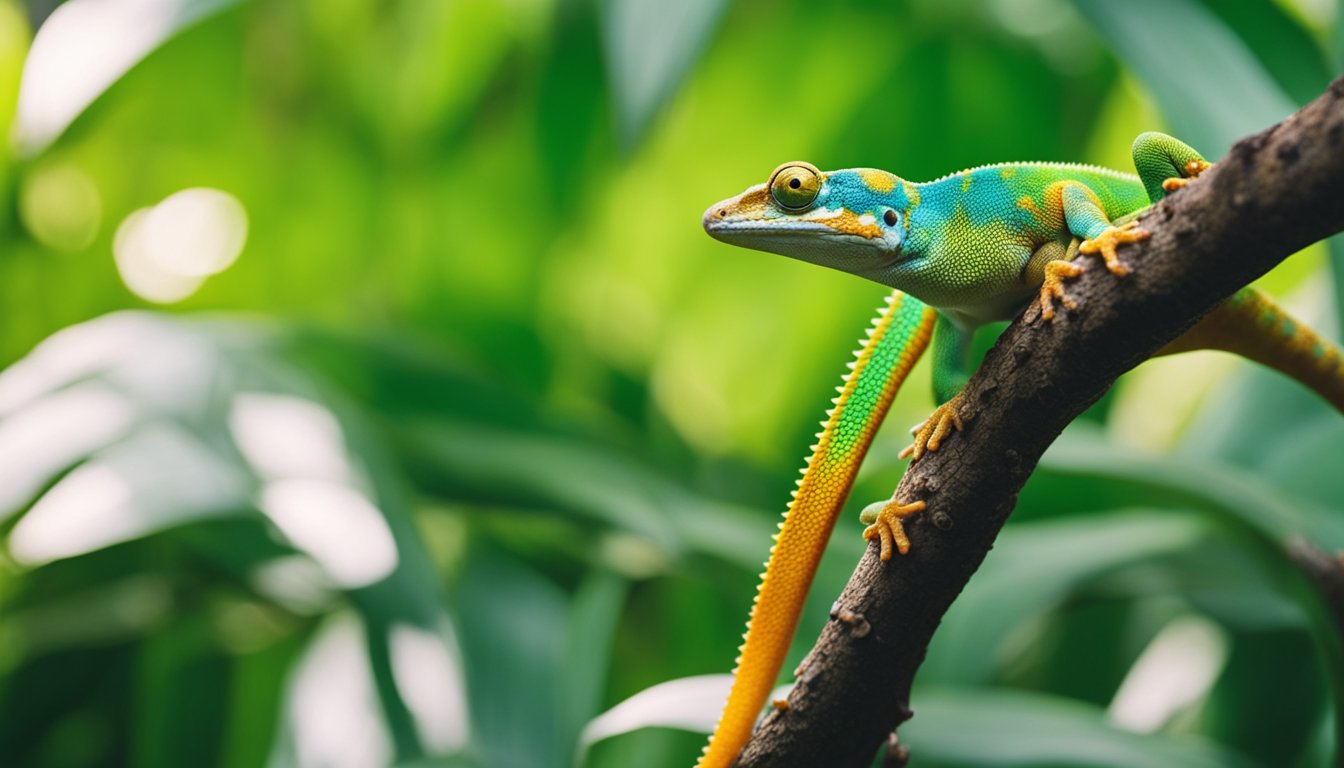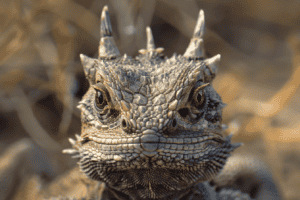Geckos are some of the most fascinating creatures crawling across the globe.
Known for their vibrant colors and gravity-defying wall climbing, these little lizards have a knack for capturing the curiosity of anyone who spots them.
Imagine being able to scamper up a wall without a single rope or suction cup, just like a gecko does!
They make use of tiny hairs on their feet called setae, which exploit the power of molecular forces to stick to surfaces with astonishing ease.

These reptilians aren’t just incredible climbers; they are also masters of disguise and survival.
Some geckos can blend into their environment so well that they become nearly invisible to both prey and predators.
They’ve adapted in remarkable ways to survive in various environments, from rainforests to deserts.
Their diverse habitat range showcases their versatility and resilience. Ever heard a strange chirping sound at night?
That could very well be the social call of a gecko, as they are one of the few lizards that have the ability to vocalize.
Interestingly, geckos also have a superpower in their tails. Yes, their tails!
When a predator gets a bit too close for comfort, a gecko can detach its tail to create an ultimate distraction, allowing it to escape.
This act, known as autotomy, is just as dramatic as it sounds.
But the real magic comes afterwards—geckos can regrow their tails, a feat that remains a subject of wonder and study.
Now, isn’t the gecko a tiny superhero in its own right?
With so many more intriguing facets to explore, these creatures are sure to leave an impression on anyone eager to learn about the natural world around them.
The Wonders of Gecko Anatomy

Geckos are extraordinary creatures with anatomy that is both intricate and fascinating, including features like gravity-defying sticky feet, a tail with a mind of its own, and eyes that outshine even the most high-tech night vision goggles.
Let’s discover the secrets behind these remarkable adaptations.
Spectacular Sticky Feet
Have you ever seen a gecko scurry up a wall as if it were nothing? It’s all thanks to their spectacular sticky feet.
Geckos possess hundreds of tiny structures called setae on the bottoms of their feet. Each seta splits into even tinier hairs known as spatulae.
This design increases the surface area, allowing geckos to exploit weak intermolecular forces called van der Waals forces.
These forces create enough attraction between the spatulae and the surface for geckos to cling to just about anything, even glass!
Tail Tales: Detachable Defenses
Imagine you could ditch a part of your body to escape from danger. That’s exactly what geckos can do with their tails.
This superpower is known as autotomy. When a predator grabs a gecko by its tail, the tail can detach, and the freed gecko scurries to safety.
The lost tail, meanwhile, continues to wriggle, distracting the predator.
What’s even more remarkable is that geckos can regrow a new tail, although it’s generally not as perfect as the original.
Eyes Like Night Vision Goggles
While humans fumble in the dark looking for the light switch, geckos can see perfectly well in near total darkness.
Their eyes are about 350 times more sensitive to light than human eyes.
They achieve this with large pupils and a high density of rods, the light-sensitive cells in their retina.
Some geckos can even see color in dim light, which is something humans can’t do.
This night vision gives geckos a significant advantage when hunting nocturnal insects.
Amazing Adaptations and Survival Skills
Geckos are a wonder of evolution with some of the most amazing adaptations seen in the natural world.
These extraordinary lizards are set apart by their unique survival skills, enabling them to thrive in various environments.
Camouflage Champions
Imagine having an outfit that changes with your surroundings, making you nearly invisible to both predators and prey.
That’s what geckos do with their skin!
They have specialized cells called chromatophores that allow them to adjust their color to blend seamlessly with the environment.
In a tropical forest, a gecko might become a deep green to match the leaves, while in a desert, earthy browns and tans are more its style.
This ability to camouflage not only keeps them safe from would-be attackers but also turns them into stealthy hunters.
Hunting and Diet: Insect Catchers Extraordinaire
At mealtime, geckos are unmatched insect catchers with some astonishing hunting tactics.
Equipped with keen eyesight, they can spot a meal—usually insects— from a significant distance.
Once their target is in sight, geckos can sneak up silently and then pounce with lightning-fast agility.
They even have a secret weapon: a sticky tongue that can snag insects right out of the air!
Here’s a crunching fact: some large geckos can eat small birds and rodents, showing their versatility and adaptability when it comes to diet.
Social Behavior and Communication

Geckos are quite the social butterflies in the reptile world. They use a variety of sounds to chat with each other.
Imagine them chirping, barking, and clicking away, like they’re exchanging the latest gossip.
Just like people have different tones when they’re happy or upset, geckos change their sounds to express their moods and intentions.
When it comes to making new friends or defending their turf, geckos rely on their body language.
A little tail wiggle can go a long way in the gecko social scene—it might mean “hello” to a neighbor or “back off” to a not-so-welcome visitor.
They even use their tails to communicate with predators, detaching them in a sticky situation to distract the enemy while they make a quick getaway!
Did You Know?
Geckos are pretty good at playing hide and seek. They can camouflage, blending into their environment so well that they become nearly invisible.
This not only helps them sneak up on their next meal but also lets them spy on what’s happening around them without being spotted.
Consider this: Have you ever tried to have a conversation in a noisy room? Geckos don’t fret about that.
Many species have sensitive hearing and can pick up on low-frequency sounds, enabling them to listen in on conversations even when there’s a lot going on around them.
It’s like having super hearing powers!
Remember, geckos aren’t just scaly creatures; they’ve got quite the personality, and understanding their social behavior and communication can give us a neat peek into their world.
Isn’t it fascinating how these little lizards have figured out ways to ‘talk’ and interact with one another?
Gecko Habitats: From Rainforests to Deserts

Geckos are fascinating creatures that have conquered an array of environments across the globe.
Imagine a world where the same type of animal can thrive in both lush, wet rainforests and arid, sandy deserts. That’s exactly what geckos do!
They have an impressive range that spans various continents and includes many diverse habitats.
Rainforests serve as a playground for many geckos.
These moisture-loving reptiles bask in the high humidity and ample foliage that offer both food and shelter.
In the dense canopy, leafy layers above, and even among the roots below, they have adapted to an incredible vertical range.
Canopies offer them a buffet of insects, while the leaf litter on the forest floor provides perfect hiding spots from predators.
Moving to the other extreme, some geckos call the deserts their home.
Despite the scarce water and extreme temperatures, these hardy species have developed unique adaptations.
They often boast thick skins that help retain moisture and protect against the hot sand, and their behavior of burrowing or finding shade helps them escape the harsh sun.
Even in these two contrasting environments, geckos demonstrate remarkable resilience.
Is it not astonishing how geckos can inhabit such different worlds?
Their special toe pads allow them to climb smooth surfaces, aiding in their survival in almost any habitat.
One can only marvel at the versatility and adaptability of these small, yet mighty, reptiles.
They truly are masters of their domains, from the tallest trees to the hidden crevices in the desert rocks!
Frequently Asked Questions

Geckos are fascinating creatures, and their world is full of wonder.
From their unique diets to the habitats they thrive in, there’s so much to explore.
Let’s discover some incredible tidbits about these critters that make them stand out in the animal kingdom.
What do geckos love to munch on during snack time?
Geckos are mostly insectivores, meaning they love crunching on a variety of insects.
Some larger gecko species can also munch on small fruits and even other smaller lizards.
They are certainly not picky eaters when it comes to their snack time!
How cozy are geckos in their natural home and what does it look like?
Geckos find comfort in a range of habitats, from rainforests and deserts to even human dwellings.
They prefer warm environments and typically make cozy homes in tree bark, under rocks, or within leaves, camouflaging themselves from predators and snoozing during the day.
Can you guess how long geckos can celebrate their birthdays for?
Some geckos have quite the lifespan and can live to celebrate many birthdays.
Depending on the species, they can live anywhere from 5 to over 20 years with proper care, making each year a new milestone in their scaly journey of life.
Why might a gecko win a superhero award in the animal kingdom?
With their extraordinary ability to regenerate lost tails, geckos might just snag a superhero award!
This amazing adaptation serves as a defense mechanism and allows them to escape predators while leaving a surprise behind.
How do geckos climb so smoothly on seemingly flat surfaces?
Geckos are master climbers thanks to the tiny hairs called setae on the pads of their feet.
These create a strong adhesive force, using the scientific principle of van der Waals forces, allowing them to scale walls and even hang upside down on ceilings.
What makes geckos such unique and interesting pets for families?
Geckos captivate with their vibrant patterns and playful nocturnal antics, providing intrigue for family members.
They are low maintenance as pets and can form a bond with their human caretakers, making them uniquely special companions that draw one closer to the wonders of nature.









